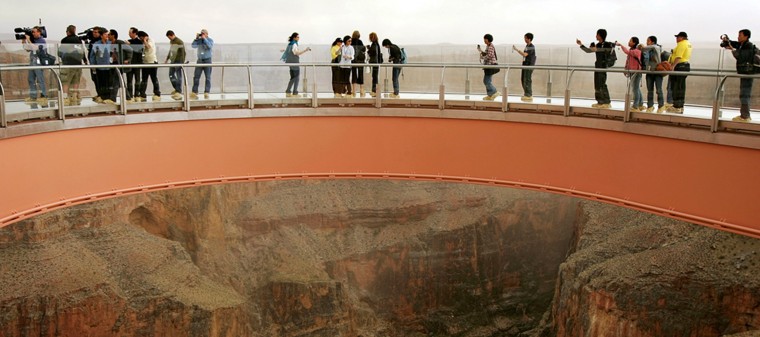Following the deaths of two people in separate incidents at the Grand Canyon this week, experts said that while such tragic cases are still incredibly rare, national parks have been dealing with a higher number of visitors with fewer resources.
On Thursday, a visitor with a tour group at the Eagle Point observation area of Grand Canyon West fell over the edge while taking a selfie, a park spokesperson said. Meanwhile, authorities at Grand Canyon National Park were working to identify the body of a person found Tuesday.
While the details of both incidents remain unknown, experts said that officials are working to keep people safe by putting up railings, posting warnings signs and having staff inform the public of dangers. But the parks are also working to do so amid declining resources.
“I know that the parks are trying to do everything they can, the question is how much can they actually do with limited resources,” Phil Francis, the head of the Coalition to Protect Americas National Parks, said.
There were more than 318 million recreational visits to national parks in 2018, according to the National Park Service. While that was down 3.8 percent from the 330 million the year before, it was still the third highest year for visits behind 2016 and 2017.
Francis said there has been a “fairly dramatic" decline in the number of employees at parks. Some of the major national parks, such as Blue Ridge Parkway and the Great Smoky Mountains, lost 20 to 25 percent of their law enforcement ranger staff over the last 10 years, he said.
That decrease could lead to longer response times in the case of an emergency or force rangers to make judgement calls on which incidents to respond to first in a triage situation, Francis said. Additional staff could also help educate the public about park history and safety.
The National Park Service did not immediately respond to request for comment on the number of deaths in national parks per year.
Francis said it was very important for visitors to plan ahead and learn as much as possible about the parks, including the best times of year to visit and weather patterns like extreme heat or cold.
“People often visit parks without fully understanding what the risks are,” he said. Any potential visitors should “spend some time before they go to fully understand what the safety hazards may be and share that information with their family."
Francis said that while he did not have the empirical data, from his experience working for several decades in national parks, “it appears that people are taking greater risks to take a selfie with their family, to get that beautiful shot.”
Michael P. Ghiglieri, who wrote “Over the Edge: Death in Grand Canyon” with Thomas M. Myers, said “in our culture today there’s a really strong tendency for people to recognize danger as an opportunity for some sort of social media post or photograph and not as actual danger.”
“It’s like a cognitive disconnect between danger as an opportunity for self-expression or danger as actual danger and that’s more and more common,” he said.
More than 60 people have fallen to their deaths from the rims of the Grand Canyon since 1925 and there are close to 20 known events of people dying at the Grand Canyon while either posing or taking pictures, Ghiglieri said.
And while deaths from extreme heat have gone up and continue to grow, the overall number of deaths at the Grand Canyon and Yosemite is down from previous decades, he said, adding that the vast majority of people who visit national parks stay safe.
While the numbers are still very low compared to the number of visitors to parks, Ghiglieri said there seems to have been an increase in deaths of people taking or posing for photos.
“But it’s not epidemic, it’s still the one in a million,” he added.



